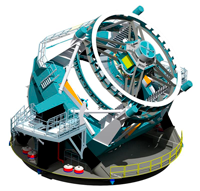 Teledyne e2v has been awarded a multimillion dollar contract by SLAC National Accelerator Laboratory (SLAC) to supply customised Charge Coupled Device (CCD) image sensors for the Large Synoptic Survey Telescope.
Teledyne e2v has been awarded a multimillion dollar contract by SLAC National Accelerator Laboratory (SLAC) to supply customised Charge Coupled Device (CCD) image sensors for the Large Synoptic Survey Telescope.
The 8.4 metre telescope is being constructed in Chile to carry out a ten-year survey of the sky to address a range of fundamental astronomy questions about dark matter, dark energy, near Earth asteroids, transient optical objects (such as supernovae), and the formation of our Milky Way galaxy.
Teledyne e2v has designed a high-performance customised sensor capable of providing exceptional sensitivity and stable performance with an extremely flat focal surface which delivers 3,200 Megapixels of image data per exposure.
The camera will incorporate 189 large-area sensors which will be delivered to SLAC for construction into the cryogenically-cooled camera. Approximately one third of the science sensors have already been delivered in a previous contract phase. The contract award follows previous prototype and 'First Article' contracts and requires Teledyne e2v to deliver essential components for the LSST.
The LSST, identified as a US national scientific priority by the 2010 USA National Research Council decadal survey, has the largest digital camera ever built for ground-based astronomy and will be one of the world’s most powerful astronomical survey telescopes when commissioned in 2021. The telescope has a novel three-mirror design to provide high efficiency and a wide field of view.
SLAC is building the camera which will record images that cover an area of 49 times that of a full moon. The powerful telescope will capture images of the entire sky every few nights in multiple colour bands. These will be used to construct a detailed catalogue of the sky, providing brightness, colour and time variability information at a greater depth than ever before.
“This telescope and camera will stimulate the astronomy world with a huge survey data set which will be followed by many astronomers worldwide and will set a new standard against which other instruments will be compared,” said Dr. Paul Jorden, Astronomy Product Specialist at Teledyne e2v. The sensors have very challenging design features and Teledyne e2v has been able to demonstrate that they can be manufactured in large quantities and delivered to a tight schedule.
The sensors supplied by Teledyne e2v will be at the very heart of the LSST camera. They have been designed for very high sensitivity and optimised for enhanced red wavelength sensitivity. The large camera requires an extremely flat focal surface, and so the Teledyne e2v sensors are designed to achieve a surface flatness precision one-twentieth of the width of a human hair.
The 189 sensors will be built in a custom package that enables all of them to be assembled into a closely-packed mosaic to form the three Gigapixel array with minimal lost area and a mere 0.25 mm gap between sensors across the 630mm diameter focal plane.
The sensors have 16 output channels that enable them to read the image in a few seconds and allow a high rate of image collection.
Author
Neil Tyler
Source: www.newelectronics.co.uk
